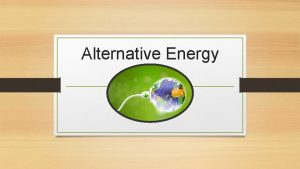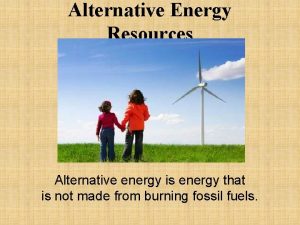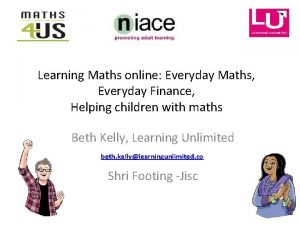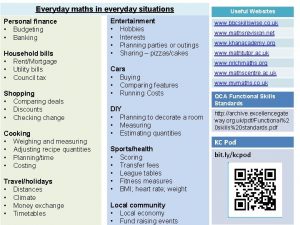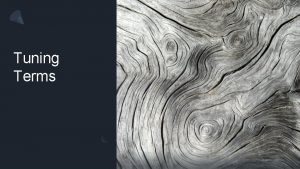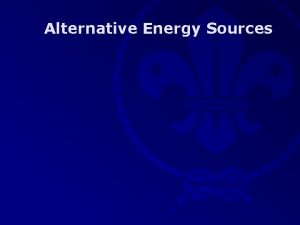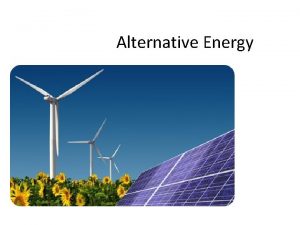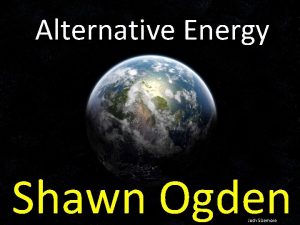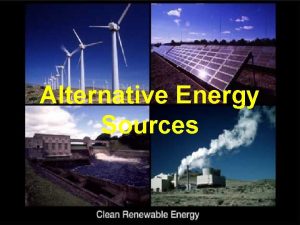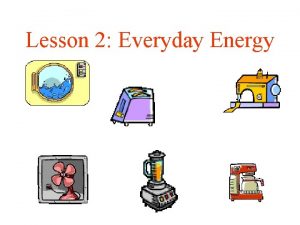Alternative Energy The need for Alternative Energy Everyday
























- Slides: 24

Alternative Energy

The need for Alternative Energy • Everyday, the world produces carbon dioxide that is released into the earth’s atmosphere. The increased content of Carbon Dioxide (CO 2) increases the warmth of our planet and is the main cause of the so called “Global Warming Effect”. • By 2050, one-third of the world’s energy will need to come from solar, wind, and other renewable resources. Climate change, population growth, and fossil fuel depletion mean that renewables will need to play a bigger role in the future than they do today.

What are Renewables? • Renewable energy (or renewables) is energy that comes from natural processes (sunlight, wind, and other natural materials) that are replenished at a higher rate than they are consumed. • Some examples: Biomass, Solar, Wind, Geothermal, and Hydroelectric.

Biomass • Biomass is biological material that comes from living, or recently living organisms. In the context of biomass for energy, this is often used to mean plant based material. • Biomass is carbon based and is composed of a mixture of organic molecules containing hydrogen, usually including oxygen, nitrogen, and small quantities of other atoms (including alkali, alkaline earth, and heavy metals).

Biomass vs. Fossil Fuels • The primary difference between biomass and fossil fuels is one of time scale. • Biomass takes carbon out of the atmosphere while it is growing, and returns it as it is burned. If it is managed on a sustainable basis, biomass is harvested as a part of a constantly replenished crop (a renewable resource). The replanting with new growth takes the CO 2 from the atmosphere at the same time as it is released by combustion of the previous harvest. • This maintains a closed carbon cycle with no net increase in atmospheric CO 2 levels.

The Problem with Biomass • The problem with biomass is that it takes time for the new plants to grow. It is also expensive to produce it in large enough quantities to make a difference. • However, as the fossil fuels become harder to find, biomass can be another energy source.

Types of Biomass

Solar Energy • Every day, the sun radiates (sends out) an enormous amount of energy – called solar energy. It radiates more energy in one second than the world has used since time began. This energy comes from within the sun itself. • Only a small part of the radiant energy that the sun emits into space ever reaches the Earth, but that is more than enough to supply all our energy needs.

Solar Power • From an environmental perspective, solar power is the best thing going. Solar power does not cause pollution and will not run out for billions of years. • However, solar power is only available when the sun is out and the energy the Earth receives is very spread out. To obtain a useful amount of power, it is necessary to collect solar energy from a large area. To create these solar power plants, habitats and ecosystems can be harmed.

Solar Plant

Wind Energy • Wind is simply air in motion. It is caused by uneven heating of the Earth’s surface by radiant energy from the sun. Wind is considered renewable because the wind will blow as long as the sun shines. • Wind farms are clusters of wind turbines used to produce electricity. They usually have dozens of turbines scattered over a large area. • Today, people are realizing that wind power “is one of the most promising new energy sources”.

Wind Farm

Geothermal Energy • Geothermal energy is the heat from the Earth. It's clean and sustainable. Resources of geothermal energy range from the shallow ground to hot water and hot rock found a few miles beneath the Earth's surface, and down even deeper to the extremely high temperatures of molten rock called magma. • Geothermal energy does have disadvantages. There are only a few places where Earth’s crust is thin enough for magma to come close to the surface. Elsewhere, very deep wells would be needed. Drilling these wells is very expensive. Even so, geothermal energy is likely to become a good method for meeting energy needs in the future.

Geothermal Energy

Hydroelectric Power • Hydroelectric power electricity produced by flowing water. • A dam across a river blocks the flow of water, creating a body of water called a reservoir. When a dam’s gates are opened, water flows through tunnels at the bottom of the dam. As the water moves through the tunnels, it turns turbines. The turbines are connected to a generator that changes mechanical energy into electrical energy. • A disadvantage of dams is that they can damage aquatic habitats.

Hydroelectric Power • Moving water is a powerful entity responsible for lighting entire cities, even countries. Thousands of years ago the Greeks used water wheels, which picked up water in buckets around a wheel. The water's weight caused the wheel to turn, converting kinetic energy into mechanical energy for grinding grain and pumping water. • People realized that the force of water falling from a height would turn a turbine connected to a generator to produce electricity. Niagara Falls , a natural waterfall, powered the first hydroelectric plant in 1879.

Hydroelectric Power

Nuclear Power • In a nuclear-fueled power plant – much like a fossil-fueled power plant – water is turned into steam, which in turn drives turbine generators to produce electricity. The difference is the source of heat. At nuclear power plants, the heat to make the steam is created when uranium atoms split – called fission. There is no combustion in a nuclear reactor.

Nuclear Power • The nuclear power plant stands on the border between humanity's greatest hopes and its deepest fears for the future. • On one hand, atomic energy offers a clean energy alternative that frees us from the shackles of fossil fuel dependence. On the other, it summons images of disaster (quake-ruptured Japanese power plants belching radioactive steam, the dead zone surrounding Chernobyl's concrete sarcophagus). Nuclear power can also be dangerous if their wastes are not disposed of properly.

Nuclear Power Plant

How Does the U. S. Measure Up? • The United States is working hard to improve the alternative energy that is offered to citizens. • The Hydropower Vision analysis finds that hydropower could grow to nearly 150 gigawatts of capacity by 2050. When this happens, more than 35 million average U. S. homes could be powered by hydropower.

How Does the U. S. Measure Up? • “Solar power is more affordable, accessible, and prevalent in the U. S. than ever before” according to the Office of Energy Efficiency & Renewable Energy. “Since 2008, U. S. installations have grown…to enough capacity to power the equivalent of 5. 7 million average American homes. Yet significant work remains before solar becomes as affordable as conventional energy sources. ”

How Does the U. S. Measure Up? • “The National Offshore Wind Strategy was published just weeks after construction was completed on America’s first offshore commercial wind farm off of Block Island, RI. The new 30 MW wind farm is expected to start operating by the end of 2016. It will generate enough electricity to power 17, 000 homes in New England. ” Many states are working hard to develop more offshore wind farms.

How Does the U. S. Measure Up? • The Department of Energy and the University of North Dakota received the Geothermal Energy Association Honors award for Technological Advancement in June, 2016. “The award recognizes the development of a new, innovative, or pioneering technology to further geothermal development. ” • Researchers successfully generated geothermal power from hot water that flows from wells in the Williston Basin in western North Dakota. The facility started generating electricity for the first time in late April.
 Kontinuitetshantering
Kontinuitetshantering Novell typiska drag
Novell typiska drag Tack för att ni lyssnade bild
Tack för att ni lyssnade bild Vad står k.r.å.k.a.n för
Vad står k.r.å.k.a.n för Varför kallas perioden 1918-1939 för mellankrigstiden?
Varför kallas perioden 1918-1939 för mellankrigstiden? En lathund för arbete med kontinuitetshantering
En lathund för arbete med kontinuitetshantering Underlag för särskild löneskatt på pensionskostnader
Underlag för särskild löneskatt på pensionskostnader Tidbok
Tidbok Sura för anatom
Sura för anatom Densitet vatten
Densitet vatten Datorkunskap för nybörjare
Datorkunskap för nybörjare Boverket ka
Boverket ka Debattartikel mall
Debattartikel mall Delegerande ledarskap
Delegerande ledarskap Nyckelkompetenser för livslångt lärande
Nyckelkompetenser för livslångt lärande Påbyggnader för flakfordon
Påbyggnader för flakfordon Kraft per area
Kraft per area Offentlig förvaltning
Offentlig förvaltning Jag har nigit för nymånens skära text
Jag har nigit för nymånens skära text Presentera för publik crossboss
Presentera för publik crossboss Teckenspråk minoritetsspråk argument
Teckenspråk minoritetsspråk argument Bat mitza
Bat mitza Klassificeringsstruktur för kommunala verksamheter
Klassificeringsstruktur för kommunala verksamheter Luftstrupen för medicinare
Luftstrupen för medicinare Claes martinsson
Claes martinsson

























